Do-it-yourself polypropylene water supply: everything about installing a system of plastic pipes
It is unthinkable to imagine comfortable housing, be it an apartment, your own cottage or a small country house, without running water. The supply of cold and heated water has long become a prerequisite for comfortable living. Homeowners try to choose the most practical water supply option.
Statistics show that the majority prefer polypropylene water supply: even an inexperienced plumber can install such a system with his own hands. In order for the result of your efforts to be impeccable, we suggest that you familiarize yourself with the detailed information polymer system assembly technology.
We presented all the methods for connecting polypropylene pipes and listed the types of fittings used in the construction of circuits. Typical errors indicated. The information we offer is supplemented with diagrams, photo collections and videos.
The content of the article:
Why choose polypropylene?
Steel has long been considered the traditional material for water pipes.
However, today this option is used quite rarely. It was replaced by various plastics, among them polypropylene.
The popularity of PP pipes is no coincidence, because the material has many advantages:
- High stability to aggressive environments During a long time. In addition, polypropylene is not subject to corrosion.
- Durability. The manufacturer guarantees trouble-free operation of its products for at least 50 years, which is three times longer than its analogues.
- Good tightness of connections. Compared to other types of plastics, it is considered the best.
- High sound absorption. The noise of water passing through the pipeline is completely absorbed by the material.
- Complete environmental safety polypropylene, it is allowed to be used for drinking water supply installations.
- Low hydraulic resistance, so there is no pressure loss.
- Light weight, which greatly facilitates the installation, repair and transportation of parts.
- Easy to install. This is due to the wide range of components, ease of cutting and fitting parts.
- Possibility of hidden installation pipeline.
The most significant disadvantages of polypropylene pipes include the high thermal expansion value and low heat resistance, which requires special attention when choosing a material for hot water supply installations.
In addition, polypropylene is not plastic, so changing the direction of the main branch requires the use of connecting fittings.
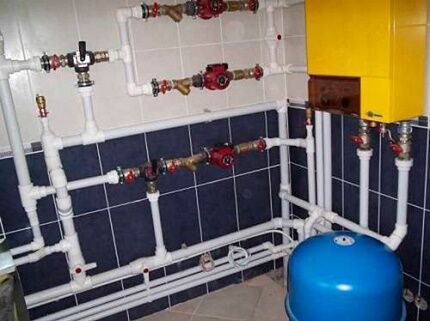
Another disadvantage of such pipes is the need to use special equipment. To connect parts, soldering is used, which is performed using a special soldering iron with nozzles.
It is advisable to use special scissors to cut elements. True, this shortcoming is easily corrected. Most stores selling polypropylene pipes provide soldering equipment for rent.
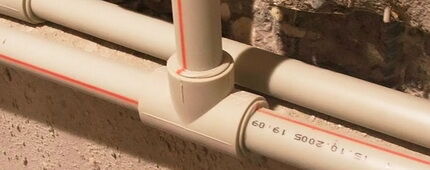
Features of the assortment of polypropylene pipes
Polypropylene is a type of plastic produced by cracking petroleum products and petroleum gases. Its basis is propylene gas. Under high pressure with the presence of a catalyst, a polymerization reaction is carried out, as a result of which polypropylene is obtained. Pipes are subsequently made from it. Two types of such products are produced for water supply systems: single and multilayer.
The first option is intended mainly for various types of pipelines through which cold water is transported. Multilayer or reinforced parts are used to construct hot water lines; they are also used for the installation of heating systems. Their main difference is the presence of several layers of polypropylene, between which reinforcing material is laid.
This can be aluminum foil, polyethylene or fiberglass. The parts differ in the thickness of the reinforcing layer and base.
In the manufacture of polypropylene pipes, the following marking of the material used in production is used:
- RR-N. Products for cold water, can be used for ventilation systems.
- RR-V. Material for the production of products with high impact resistance. Designed for cold water supply and floor heating.
- PP-R. Pipes made from it can be used to install any type of water supply system.
- PPs. It is used in the production of low-flammability products intended for pipelines through which hazardous substances are transported.
The classification of materials used in the manufacture of pipeline products from thermoplastics for the construction of communications is given in GOST number 52134-2003.
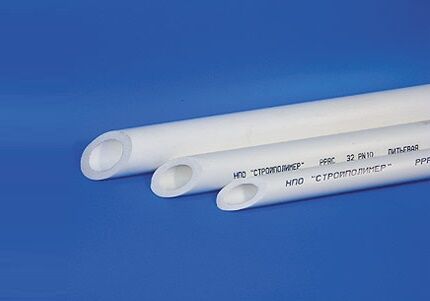
The marking of finished products is different.The following nomenclature designations are used for polypropylene pipes:
- PN10. Products manufactured for the transportation of cold water with an operating temperature of no more than +20º C.
- PN16. Universal products that can be used for the construction of cold and hot water pipelines. However, the temperature of the liquid should not exceed +60º C. It is produced rarely, and in limited quantities.
- PN20. Pipes ensuring normal transportation of liquid tº +80ºС. By analogy with the previous type, it is considered universal.
- PN25. High pressure resistant parts can be used for both plumbing and heating. The pipes are reinforced with aluminum foil and can be used to transport water with temperatures up to +95ºС.
According to the marking of the pipes, the pressure that the PP pipes can resist when water moves through them is determined. For example, PN 10 pipes operate normally at 1 MPa, PN 20 at 2 MPa, PN 25 at 2.5 MPa.
Polypropylene is sensitive to ultraviolet radiation, so pipes are available in different colors. Black parts have the greatest resistance to UV radiation. The production of polypropylene pipes is standardized, so they are produced in certain sizes.

The first thing you need to pay attention to is the internal and external diameters. They can be indicated either in inches or in the usual millimeters. The diameter values determine the selection of the dimensions of the fittings that will be used to connect the pipeline parts.
The outer diameter of the products varies from 16 to 500 mm. The length of the pipes can be from 2 to 5 m, which is quite enough for arranging an internal water supply system. Moreover, the products are easy to process.

Accessories for polypropylene pipes
For installation water supply from plastic pipes Various components are used. Their assortment is very extensive and amounts to dozens of items in the price lists of manufacturers. The parts vary in shape, size and purpose. Let's look at the most common types of such elements.
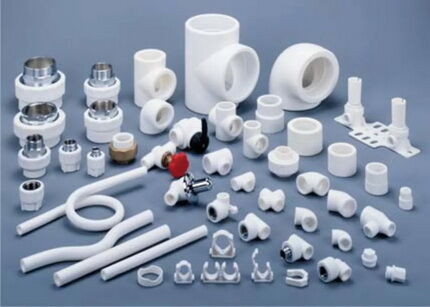
Couplings. The simplest connecting part. The shape resembles a small barrel, the inner diameter of the hole exactly matches the cross-section of the pipes being connected. The element is intended to connect two sections of pipe.
Adapters. These parts are designed to connect pipes of different diameters. Outwardly, they are very similar to couplings, but their main difference is that the internal diameter at the two opposite ends of the element is different.
Adapters are selected according to the diameter of the pipes being connected and come in various sizes. Parts are produced with internal or external threads, designed for transition to threaded connections.
Corners. As is known, polypropylene pipes cannot be bent.Therefore, to perform the rotations necessary during installation, the manufacturer produces special connecting parts bent at an angle of 90° and 45°.
The corners can end with holes for pipes or have threads, both internal and external. For example, such parts are used to install a mixer. Moreover, they can be either double or single.
Some home craftsmen argue that there is no need to complicate things and use corners. After all, polypropylene is plastic and can be bent. They heat the pipe to softening temperature and bend it the way they want.
Indeed, it is very easy to bend a part, but you need to understand that unpleasant changes occur in it: the wall on the outside of the bend becomes thinner. This will significantly reduce the life of the pipe and lead to its breakthrough.
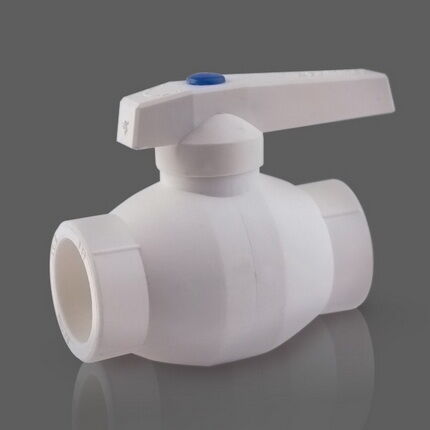
Crosses and tees. These are the names of elements designed to connect three or four pipes at the same time, which is often required for installing a water supply system. They are produced in a wide variety of variations: with hole diameters of different sizes, with fittings for other types of pipes, for example, for metal-plastic or copper, with internal and external threads of various sizes.
Contours. This is the name given to specially formed bends that are used to guide the pipe around a small obstacle. In this case, it is desirable that the distance from the pipeline to the wall be minimal. The bypass is welded into the gap in the water supply section so that the sections of pipe lying before and after it are straight.
In addition to these components, other elements are also produced.Among them are plugs used to shut off unnecessary branches of the water supply system, and special ball valves for polypropylene pipelines.
To secure the pipes to the wall, special clips are used, which are selected to match the diameter of the part. Can be single or double. Experts advise choosing pipes and components from the same manufacturer. This way there will be fewer problems during installation, and the system will be of higher quality.
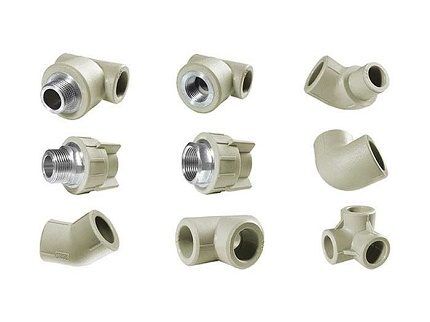
Starting stage: where to start?
First of all, you need to draw up a competent design of the future system. This means a schematic plan of the pipeline made to scale, on which all design features are plotted and consumers are indicated.
To do this, it is necessary to take accurate measurements, which are subsequently used to construct a drawing of the building. After it is completed, a pipeline diagram is built.
At creating a project Different options for arranging plumbing fixtures are considered and the optimal one is selected. In addition, several factors must be taken into account during the design process. The first is the type of wiring.
It can be tee or manifold. In the first case, water collection points are connected sequentially, one after another. On the one hand, this is good, since a minimum number of pipes is required and, therefore, low costs.
However, the pressure in water consuming devices will be different. The further from the beginning of the pipeline, the lower the pressure.This is extremely inconvenient, and in the case of a large number of water points, unacceptable.
Collector wiring presupposes the presence of a special distribution unit that separates water flows and directs an individual branch to each consumer.

In this case, there is practically no pressure loss in the system; all devices operate with the same water pressure. The main disadvantage of collector wiring is the high consumption of pipes and, accordingly, the higher cost of the entire structure.
The second important point is the method of installing the pipeline. This can be done openly or covertly. The second is more aesthetic and involves laying pipes inside walls or partitions.
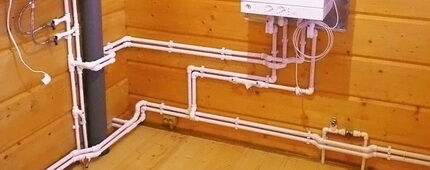
In addition, when designing a pipeline, experts recommend reducing its length as much as possible. The number of folds and joints should be minimal. This is explained by the fact that it is in these areas that the threat of leakage is most likely.
Turning the pipe at right angles reduces the pressure in the main; this must also be taken into account. Using the finished diagram, the required amount of materials for laying the water pipeline is calculated.

How to connect polypropylene pipes?
Soldering is used to connect polypropylene pipe sections.This is done using a special soldering iron. Using such a device is easy. Anyone, even the most inexperienced plumber, can learn this very quickly.
Process soldering of polypropylene pipes as follows. First you need to prepare the parts that need to be soldered. To do this, pipe fastening areas are marked on the wall.
After that, using a level, the correctness of the marking is checked, then so-called clips or mounting supports are installed on the wall. Then you need to measure the pieces of pipe that will need to be connected, and then cut them with a cutter or special scissors.
Now you can start soldering. First you need to choose a nozzle for your soldering iron. The device comes with several of these items.
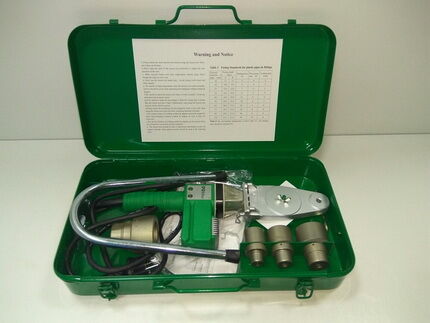
They differ in the diameter of the working surface. The nozzle is selected in accordance with the cross-section of the pipe and fitting. The part is installed in place and the soldering iron is turned on. There is always a temperature regulator on the body of the device, with which you can control the heating of the nozzles.
To work with polypropylene, it is recommended to choose the range of 250-270ºС.
The fitting and pipe are put on the corresponding heated soldering iron nozzles and heated for about 5-10 seconds. This depends on the diameter of the elements. The larger it is, the warming up time is correspondingly longer.
After the parts will warm up, they are removed from the nozzles and immediately pressed together. In this case, a twisting movement must not be made. The elements do not rotate, but are pressed against one another.
They are held in this position for about half a minute.During this time, the plastic will have time to harden and you can remove your hands. After the polypropylene has completely cooled, a strong monolithic connection of the two units is formed.
A sign of quality work is a uniform bead that is visible along the entire circumference of the pipe. It is also inside the fitting, you just can’t see it there.
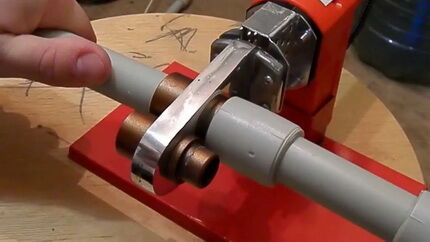
The bead is formed when the part is heated. If it is uniform, then heating occurred normally. If the parts are heated unevenly, the height of the bead will be different. Where it is least, a leak is likely to appear later.
An important point is the quality of soldering iron attachments. They are coated with Teflon to prevent plastic from sticking to them. During operation, the Teflon layer becomes thinner and even disappears.
Experts strongly do not recommend using nozzles that are partially coated with a non-stick coating. This is due to the fact that when heated, the plastic will definitely stick to those areas of the nozzles that are not covered with Teflon.
This does not mean that the part cannot be removed from the attachment. It will come off perfectly, but the connection will be of poor quality. There is a very high probability that where the element has stuck to the nozzle, a leak will subsequently appear.
General installation features
It may seem to a novice plumber that the process of installing a polypropylene pipeline is complicated, but this is not so. Before work, you will need to prepare all the necessary materials. Their type and quantity are easily determined from a previously drawn up construction project.
If such work is being carried out for the first time and welding experience is still very small, it is worth buying everything “with a reserve” in case of possible damage.
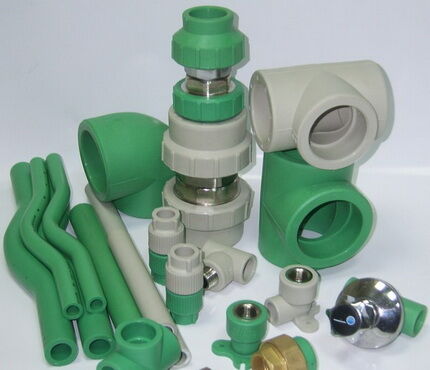
You should start laying the water supply not from its beginning, as it may seem, but from the water collection points. Attaching to water consuming devices is done using adapters of suitable size with a threaded connection.
It is strongly recommended to install before each plumbing fixture ball valve, which will allow you to quickly turn off the water supply if necessary.
The branch goes from the consumer to the collector or to the next water collection point. It depends on the type of wiring. In any case, the pipe is laid so that it can be repaired without problems. To do this, it is fixed so that the distance between the wall and the part is at least 20 mm.
Fastening clips are placed at a distance of no more than 1.5 m from one another, as well as at each corner connection and at turns.
It is important to try to minimize the number of pipes passing through partitions or walls. Each of these passages must be equipped with a sleeve or glass, inside which pipes are laid.
If the system has drain taps, the pipes should be laid with a slight slope towards them. All rounds and corners are made only with the help of special fittings.
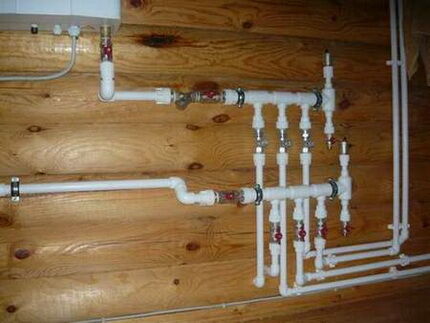
When the branch is pulled to the collector, it is connected.It must be remembered that before connecting to the outlet of the collector, it is necessary to install shut-off valves as close to it as possible.
Each branch of the water supply system is connected to its “own” outlet of the collector. This is true for both cold and hot water pipelines.
If the number of outlets on the collector comb is greater than necessary, the excess can be cut off. After this, a plug is welded onto the open part. In the case where there are not enough outlets, you can additionally weld an elbow-coupling.
It is best to have it already with the transition to the diameter needed for the job. If desired, you can make a homemade manifold with the required number of outlets by welding it from several fittings.
At the last stage of installation of a plastic water supply system, the branches prepared and connected to the collectors are assembled into a single system. Let's consider a typical version of this design. Its beginning occurs at the site where it connects to the centralized highway.
If we are talking about autonomous system, then its beginning will be considered the place of connection to the well, well or other source of water. In the first case, water meters are installed immediately after the insertion section.
If the water supply is supplied to a private house, then some part of it will be laid along the street. This is the so-called external section of the highway.
In areas with cold climates, the external water supply is laid in a trench, the depth of which exceeds the freezing level of the soil. At the same time, it is also advisable to insulate the main line so that the water in it does not freeze in the most extreme cold.
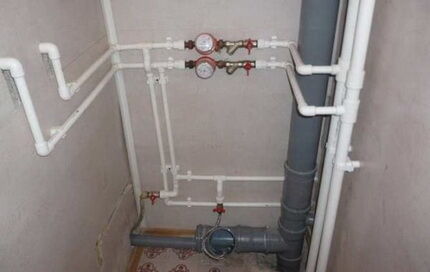
The system is brought to the house, it is introduced into the building, and then the internal plastic water supply is installed. At the point where the pipe enters the house or apartment, a coarse filter must be installed.
It will be quite enough to get rid of the largest particles of contaminants present in the water. Next, it is advisable to install more filters in front of each household and plumbing fixture.
The kitchen is usually equipped with the appropriate type of purification equipment for the production of potable water. If you plan to organize water heating, then a tee should be installed after the coarse filter. It will divide the incoming water flow into two branches. The first one will be cold, the second one will be hot.
The cold water pipe immediately after the tee must be connected to the corresponding manifold. It, in turn, connects to the wiring running throughout the building. The branch through which hot water will flow is first connected to the heating device. This must be done exactly according to the instructions.
Next, a hot water collector is installed. Everything else is similar to the “cold” pipeline.
Common mistakes and how to avoid them
Errors in operation are quite possible. To prevent an unpleasant situation, it is worth finding out what the most common mistakes are in order to try to prevent them. All pipeline branches near water collection points must end with couplings with external threads, which are used to connect plumbing fixtures. This is true for all devices except the bathroom faucet.
This requires fittings with internal threads. This is often forgotten, and you have to either buy new couplings or install fittings. Many mistakes are associated with soldering pipes.
If during the alignment process the pipe is not inserted into the fitting all the way, then a small gap will remain between its inner part and the end of the part. It is a section with a smaller wall thickness and a larger internal diameter than the pipe itself.
For this reason, the operating pressure in this section will be lower than in the rest of the system. Another problem can arise when excessive force is applied when connecting two parts.
In this case, the shoulder formed during the compression process will be too high. It will become an obstacle to the movement of water through the pipeline. Overheating of elements has a similar effect.
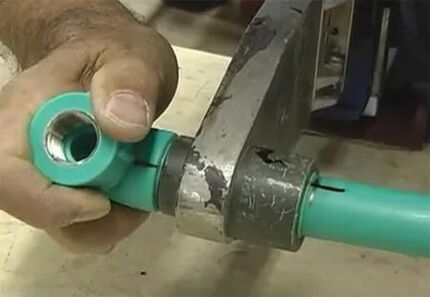
The internal cross-section of the parts is reduced, and from the outside it is completely invisible. Insufficient heating of the elements is also dangerous.
The connection will look absolutely normal, but it will be extremely unreliable and will leak quite quickly. To prevent this, it is important to always pay attention to the temperature of the soldering iron and remove heated parts only when the control light goes out.
Conclusions and useful video on the topic
Video #1. All about the types of polypropylene pipes:
Video #2. Professional plumbers reveal the secrets of working with polypropylene pipes:
Video #3. Example of incorrect pipe soldering:
Water supply made from polypropylene pipes is an excellent alternative to the traditional metal system.Many advantages make its use very attractive for homeowners, and the relative ease of installation allows even the most experienced home craftsman to cope with the installation of such a system.
However, the advice of professionals should not be neglected. Then the new water supply system will delight you with long and uninterrupted operation.
Would you like to tell us how you assembled a polypropylene pipeline yourself? Do you know the nuances that will be interesting and useful to site visitors? Please write comments in the block located below the text of the article.
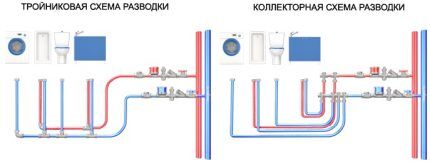




On the one hand, such pipes are a real salvation from corrosion and the need to constantly paint the pipeline. But on the other hand, they are more difficult to repair if such a need arises. Naturally, more often than not, a leak can form at a joint, and here it is not enough to simply wrap it up with tow, tighten it, or put a clamp on it—you have to redo the entire assembly. There is only one piece of advice - buy high-quality materials and don’t skimp on calling a good craftsman.
Igor, everything can be repaired perfectly, much easier than with steel pipes. As a last resort, just cut out a piece and solder a new one in 10-15 minutes.
I completely agree that polypropylene pipes are much more practical than steel pipes and have many advantages over them. But I would argue about the ease of installation. Starting to solder PP pipes without knowing how to do it is not the best idea. In addition, the service life of such pipes is long, so once in a lifetime you can, as they say, go broke and hire a normal craftsman.Moreover, installation will still require special equipment, which is stupid to buy yourself just to make your own plumbing.
In fact, you can buy a soldering iron for about fifteen hundred thousand and it will be quite suitable for use (in everyday life, for sure). I believe that any man should have a set of necessary tools in his arsenal, from a screwdriver to just a simple soldering iron.
I was slightly confused when I read that plastic has some significant disadvantages, while polypropylene pipes are the most ingenious invention in plumbing for the entire existence of this line of activity. Plastic has completely changed the idea of plumbing in terms of reliability and durability. Whenever I remember this fuss with metal, it makes me shiver.
Special soldering irons are used for polypropylene pipes. How often do you solder PP pipes to spend money on it? Yes, a man should have a set of tools, but if you buy every highly specialized tool, then no money will be enough.
If you don’t have 2000-2500 rubles to purchase a soldering iron, then you can catch it at some sale, of which there are always plenty. I believe that a 2000 watt soldering iron should be in every family household. You can give it to your relatives to use, if necessary. And he can feel the urge to solder at any moment. From installing a summer shower to completely replacing the plumbing in the house. A man should have as many tools as he needs.
Grinder, hammer drill, metal drill, screwdriver, jigsaw, miter saw, chain saw, plane, welding machine, sharpening machine, concrete mixer - this is a very important list, against the background of which the purchase of welding for pipes is a drop in the bucket.
Hello. Purchasing such a soldering iron is beneficial when independently assembling an autonomous water supply system. The cost of budget models is quite low, as the commentator below answered - from 2,500 thousand. It depends on the region, but in our city, for example, 1 soldering point costs about 180-300 rubles for specialists, renting a tool costs 1000 rubles for 24 hours.
And if you need to repair pipes, replace individual parts of them, or modernize the water supply system, or bring water outside for irrigation or a summer shower, the benefits of purchasing become even more obvious.
Please help me choose what material the heating hot water pipe should be made of, diameter 16. We live on the top floor and there is a common pipe. For the last 50 years it has been steel, but intact and hot. The neighbors want to change theirs, is there a need for me to do this too? I know that the heat transfer of plastic pipes is low - is it worth depriving yourself of heat? And if it has to be done, what material should it be made of? Thank you.
Hello. I don’t understand, if the pipe is intact, what’s the point of changing it. Moreover, you live in an apartment where independent replacement implies repairs, responsibility and maintenance by you personally if problems arise, and not by the management company. That is, if you really want it for aesthetic reasons, change it, but if you are in two minds, the neighbors change it, maybe for me, then it’s not worth it.